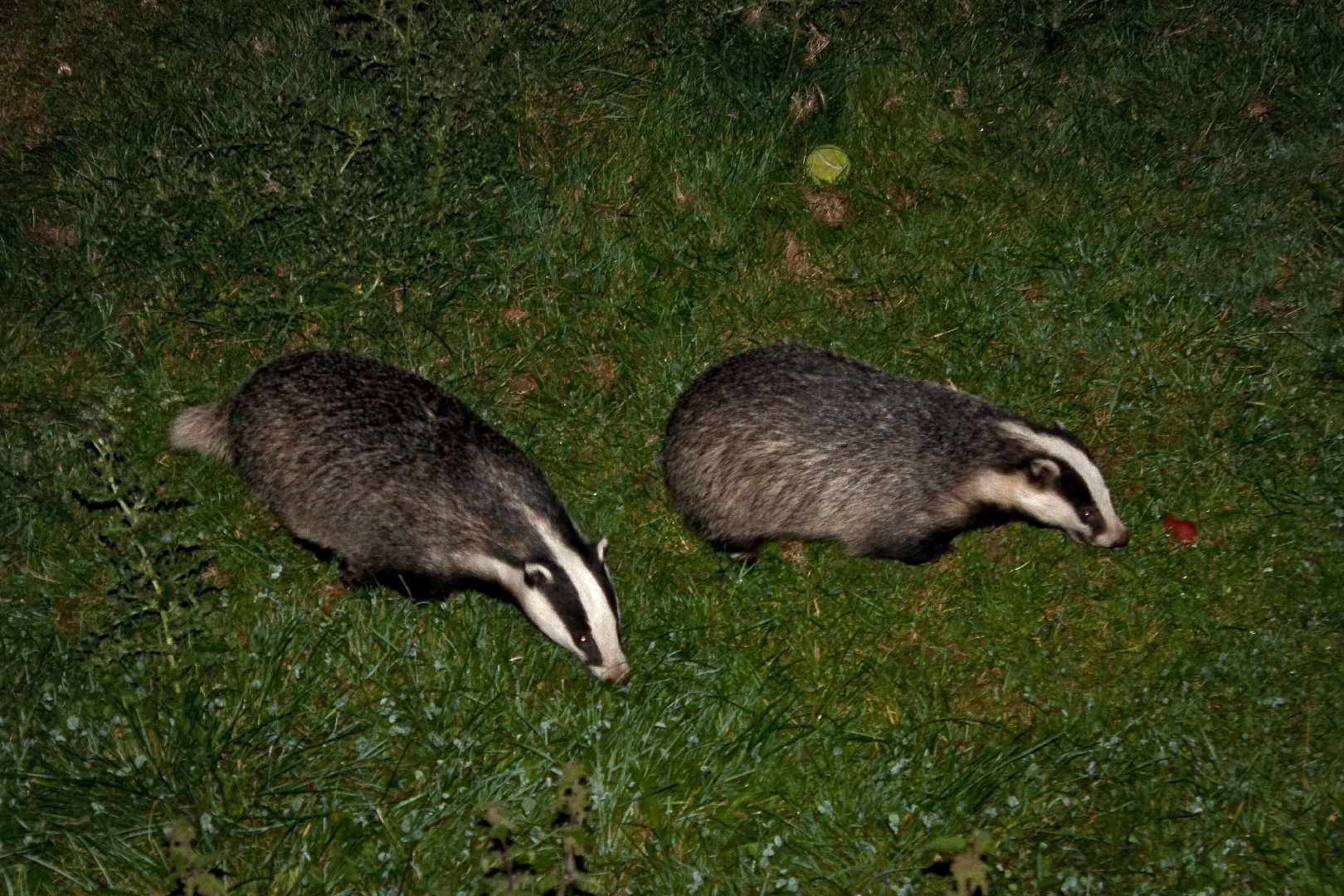European badger
A species of European badgers, Also known as Badget, Badger Scientific name : Meles meles Genus : European badgers
European badger, A species of European badgers
Also known as:
Badget, Badger
Scientific name: Meles meles
Genus: European badgers
Content
Description General Info
 Photo By Mark Robinson , used under CC-BY-2.0 /Cropped and compressed from original
Photo By Mark Robinson , used under CC-BY-2.0 /Cropped and compressed from original Description
European badgers are powerfully built animals with small heads, thick, short necks, stocky, wedge-shaped bodies and short tails. Their feet are plantigrade or semidigitigrade and short, with five toes on each foot. The limbs are short and massive, with naked lower surfaces on the feet. The claws are strong, elongated and have an obtuse end, which assists in digging. The claws are not retractable, and the hind claws wear with age. Old badgers sometimes have their hind claws almost completely worn away from constant use. Their snouts, which are used for digging and probing, are muscular and flexible. The eyes are small and the ears short and tipped with white. Whiskers are present on the snout and above the eyes. Boars typically have broader heads, thicker necks and narrower tails than sows, which are sleeker, have narrower, less domed heads and fluffier tails. The guts of badgers are longer than those of red foxes, reflecting their omnivorous diet. The small intestine has a mean length of 5.36 metres (17.6 ft) and lacks a cecum. Both sexes have three pairs of nipples but these are more developed in females. European badgers cannot flex their backs as martens, polecats and wolverines can, nor can they stand fully erect like honey badgers, though they can move quickly at full gallop. Adults measure 25–30 cm (9.8–11.8 in) in shoulder height, 60–90 cm (24–35 in) in body length, 12–24 cm (4.7–9.4 in) in tail length, 7.5–13 cm (3.0–5.1 in) in hind foot length and 3.5–7 cm (1.4–2.8 in) in ear height. Males (or boars) slightly exceed females (or sows) in measurements, but can weigh considerably more. Their weights vary seasonally, growing from spring to autumn and reaching a peak just before the winter. During the summer, European badgers commonly weigh 7–13 kg (15–29 lb) and 15–17 kg (33–37 lb) in autumn. The average weight of adults in Białowieża Forest, Poland were 10.2 kg (22 lb) in spring but weighed up to 19 kg (42 lb) in autumn, 46% higher than their spring low mass. In Woodchester Park, England, adults in spring weighed on average 7.9 kg (17 lb) and in fall average 9.5 kg (21 lb). In Doñana National Park, average weight of adult badgers is reported as 6 to 7.95 kg (13.2 to 17.5 lb), perhaps in accordance with Bergmann's rule, that its size decreases in relatively warmer climates closer to the equator. Sows can attain a top autumn weight of around 17.2 kg (38 lb), while exceptionally large boars have been reported in autumn. The heaviest verified was 27.2 kg (60 lb), though unverified specimens have been reported to 30.8 kg (68 lb) and even 34 kg (75 lb) (if so, the heaviest weight for any terrestrial mustelid). If average weights are used, the European badger ranks as the second largest terrestrial mustelid, behind only the wolverine. Although their sense of smell is acute, their eyesight is monochromatic as has been shown by their lack of reaction to red lanterns. Only moving objects attract their attention. Their hearing is no better than that of humans. European badger skulls are quite massive, heavy and elongated. Their braincases are oval in outline, while the facial part of their skulls is elongated and narrow. Adults have prominent sagittal crests which can reach 15 mm tall in old males, and are more strongly developed than those of honey badgers. Aside from anchoring the jaw muscles, the thickness of the crests protect their skulls from hard blows. Similar to martens, the dentition of European badgers is well-suited for their omnivorous diets. Their incisors are small and chisel-shaped, their canine teeth are prominent and their carnassials are not overly specialized. Their molars are flattened and adapted for grinding. Their jaws are powerful enough to crush most bones; a provoked badger was once reported as biting down on a man's wrist so severely that his hand had to be amputated. The dental formula is 3.1.3.13.1.4.2. Scent glands are present below the base of the tail and on the anus. The subcaudal gland secretes a musky-smelling, cream-coloured fatty substance, while the anal glands secrete a stronger-smelling, yellowish-brown fluid. 
General Info
Lifespan
4-7 years
Diet
The dietary profile of european badger is principally omnivorous, favoring earthworms predominantly. Its substantial diet comprises insects, small mammals, fruits, and roots, and it occasionally scavenges carrion.
Appearance
European badger is a medium-sized mammal, barrel-shaped with agile, short legs, and rough fur. Its coat is primarily black with conspicuous white stripes that run from its snout over its back into its tail. Distinctive features include small, bright eyes and a compact but strong frame. There are no significant physical variations due to age, gender, or subspecies.
Behavior
European badger is predominantly nocturnal, conducting active foraging during nighttime. This species uses complex underground burrow systems, demonstrating impressive digging behavior. European badger is notably social, with groups sharing interconnected burrow systems. It's known for its unique anal scent gland used for territorial marking. Winter torpor is a vital survival adaptation, not full hibernation but reduced activity and metabolism.
Population
Stable
Scientific Classification
Phylum
Chordates Class
Mammals Order
Carnivores Family
Mustelids Genus
European badgers Species
European badger